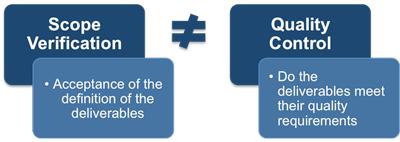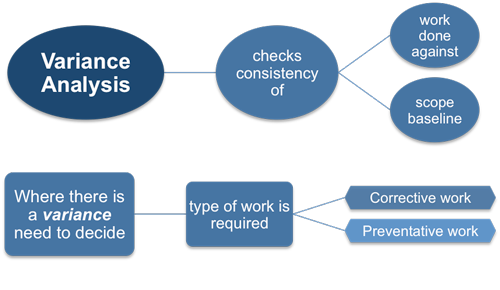Validating and Controlling Project Scope
Scope validation confirms that the work being considered matches the details in the WBS, project scope plan and project plan. This is done using reviews or audits and user trials. It differs from quality control because it is concerned with the acceptance of the definition of the deliverables while quality control is concerned with whether or not the deliverables meet their quality requirements.
 |
If a project has to be terminated early for any reason the process of scope verification is still required to determine the degree of project success. The verification report document should document what was achieved up to the point of termination because this information could establish the start point for follow up action.
Once the approval of a deliverable is formally declared, project documentation should be generated to state acceptance of this fact. Sometimes confirmation of acceptance may need to be signed off by both the sponsor and customer before formal compliance is granted. If a deliverable is not accepted then a formal document stating noncompliance should be produced instead. In other words, if the deliverables are accepted, then the project continues as before; however, if the deliverables are not accepted, then change requests are generated which will bring the deliverables in line with the customer's requirements.
Inspection includes activities such as measuring, examining, and verifying to determine whether work and deliverables meet requirements and product acceptance criteria. Inspections are sometimes called reviews, product reviews, audits, and walkthroughs. In some application areas, these different terms have narrow and specific meanings.
Controlling the scope means managing the changes to the scope baseline. There will inevitably be changes to this but it is important to ensure that these changes do not build upon each other incrementally. This is something referred to as scope creep and always produces unacceptable risks because the combined effects of these incremental changes are seldom considered in total.
The project plan contains the following components to control scope:
- Scope Baseline - this represents the approved project scope and is used during scope change management to determine and prevent scope creep. The scope baseline comprises the project scope statement, work breakdown structure and WBS dictionary.
- Scope plan - this is a subsidiary of the project plan that describes how scope will be managed, controlled and details the management and approval procedure for changes to the scope baseline.
- Change management plan - this represents an ongoing process and is outlined during the planning phase of the project and describes the steps that will be followed to initiate, review, and resolve change requests within the project. Its intended audience is the project manager, project team, project sponsor and any senior leaders whose support is needed to carry out the plan.
- Configuration management plan - this is designed to ensure that adequate controls are in place over all processes, configuration items and project deliverables.
- Requirements management plan - this is a subsidiary of the project plan and describes how requirements will be prioritized, managed, controlled and details the management and approval procedure for changes to the scope baseline.
Project performance measurements are used to assess the magnitude of variation from the original scope baseline. Important aspects of project scope control include determining the cause and degree of variance relative to the scope baseline and deciding whether corrective or preventive action is required.
 |
Using this information the project manager can check whether there is consistency between the work actually performed and the scope baseline. In case of any differences the project manager can propose corrective or preventative action by issuing change requests, which may lead to updates to the project plan.
The first stage of this evaluation means that a requested change is thoroughly reviewed against the product scope of the project scope before passing on to the next process. The justification for a change could be generated from variance identified from the work performance information. The outcome could then determine the corrective action is required to eliminate the variance. After completing the first evaluation a requested change, corrective action can only be considered once it has been through the integrated change control process.
If the action is successfully approved the next step is to return to scope control and update the project plan and components of the scope baseline. If the approved changes have an affect on the project scope then you may need to revise and reissue the project scope statement, the work breakdown structure and the WBS dictionary.
Analysis of scope performance can result in a change request to the scope baseline or other components of the project plan. Change requests can include preventive or corrective actions or defect repairs. Change requests are processed for review and disposition according to the change control process.
You may also be interested in:
Project Scope Management | Scope Creep and Project Change Control | Planning How to Manage the Project Scope | Documenting the Project Requirements | Creating a Project Scope Statement | Creating the Work Breakdown Structure | Validating and Controlling Project Scope.
|
|


